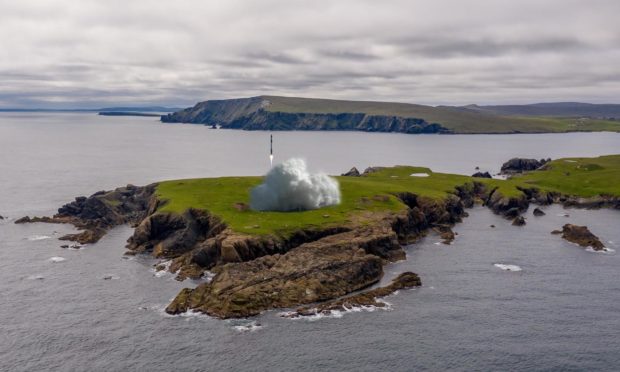Scotland’s natural heritage agency is insisting a proposed space centre in Shetland does not carry out rocket launches during the breeding season for important seabird colonies in the islands.
NatureScot fears that without protection the protected populations on the island of Unst could decline and even disappear,
It believes the launches could affect “internationally important natural heritage interests” and operations manager for the northern isles, Daniel Brazier, says the agency will object to the proposal unless conditions on the spaceport’s operation are imposed.
Major planning proposals were submitted to Shetland Islands Council in January on behalf of Shetland Space Centre.
Backers say creation of a space rocket launch centre on Unst could provide hundreds of new jobs and boost the local economy.
But Mr Brazier said: “The proposal could affect Hermaness, Saxa Vord and Valla Field Special Protection Area (SPA), protected for its breeding seabird colony, breeding red-throated diver and a number of breeding seabird species.
“Our advice is that this proposal is likely to have a significant effect on the guillemot, kittiwake, fulmar and shag features of the SPA.
“Consequently, Shetland Islands Council, as competent authority, is required to carry out an appropriate assessment in view of the site’s conservation objectives for its qualifying interests.”
Mr Brazier’s advice in his submission to the planning proposal is “that no launches or static tests are carried out between mid-May and the end of June to avoid disturbing birds during the critical incubation and early brooding period”.
Risk of population decline
He added: “Disturbance of incubating birds or those attending young chicks can result in loss of eggs or young to predators or through chilling.
“Guillemots are particularly at risk as they lay their eggs directly onto rock ledges and if panicked into leaving hurriedly en-masse, large numbers of eggs can roll or be knocked off and lost.
“Repeated loss of eggs and chicks over several years would result in population decline and possibly abandonment of the colonies.
“If observation of birds attending the colonies during the pre-laying period (mid-April to mid-May) shows that launches do not significantly increase disturbance then this condition may be relaxed.”
Nature Scot has said many species recorded as nesting in the vicinity of the launch site are listed on Schedule 1 of the Wildlife and Countryside Act, which makes it an offence to deliberately or recklessly disturb them when they are on or near their nests or to disturb their dependent young.
Mt Brazier added: “Neither development nor operation of the facility would be a licensable activity so a bird protection plan should be prepared setting out measures to avoid disturbance.
“The proposed screening bund is likely to be sufficient to prevent disturbance of one nesting site.
“Measures to prevent disturbance at the other locations might include suspending operations if breeding birds are present, or habitat modification to prevent them breeding near the launch site, combined with off-site habitat enhancement to create compensatory nesting sites elsewhere.”
Nature Scot said it would be “happy to advise the developers further on this should they wish”.
Otters have also ben recorded around the chosen site and there have been calls for monitoring, together with a warning that a licence would be required for the demolition of derelict buildings used by otters for shelter.
Shetland’s leading archaeologist Val Turner has also expressed concern over the proposed location of a spaceport in the islands.
She said the current plans could impact on historical sites and monuments in the north-east peninsula of the most northerly island of Unst.
In particular, she said it would have an adverse effect on monuments associated to RAF Skaw, one of the most prominent radar stations built in the UK in the Second World War.
The proposals
The proposals lodged by consultants Farningham Planning on behalf of Shetland Space Centre take the form of three separate but related planning applications, including the launch site at Lamba Ness.
Provision is made for the construction of three launch pads and associated infrastructure, including a satellite-tracking facility, hangar and integration facilities, the creation of a range control centre at the former RAF Saxa Vord complex, use of the fuel storage facility at Ordale Airport at Baltasound, and improvements to the launch site approach roads.
The proposals include the building of a wildlife hide at Lamba Ness to enhance public access for bird and whale watching.
The backers expect the launch site will create 140 jobs on Unst and inject at least £4.9 million a year into the island’s economy.
They also claim it will provide a further 70 jobs throughout Shetland, adding a further £2.9m in gross value per annum to the economy.
The application claims the launch facility will have no or negligible impact on local bird species, although mitigation measures have been identified.
A Shetland Space Centre spokesman said: “As with any large planning application, we expect a wide range of comments from interested parties.
“Once we have received them all, we will assess them in the round and respond in detail.”
